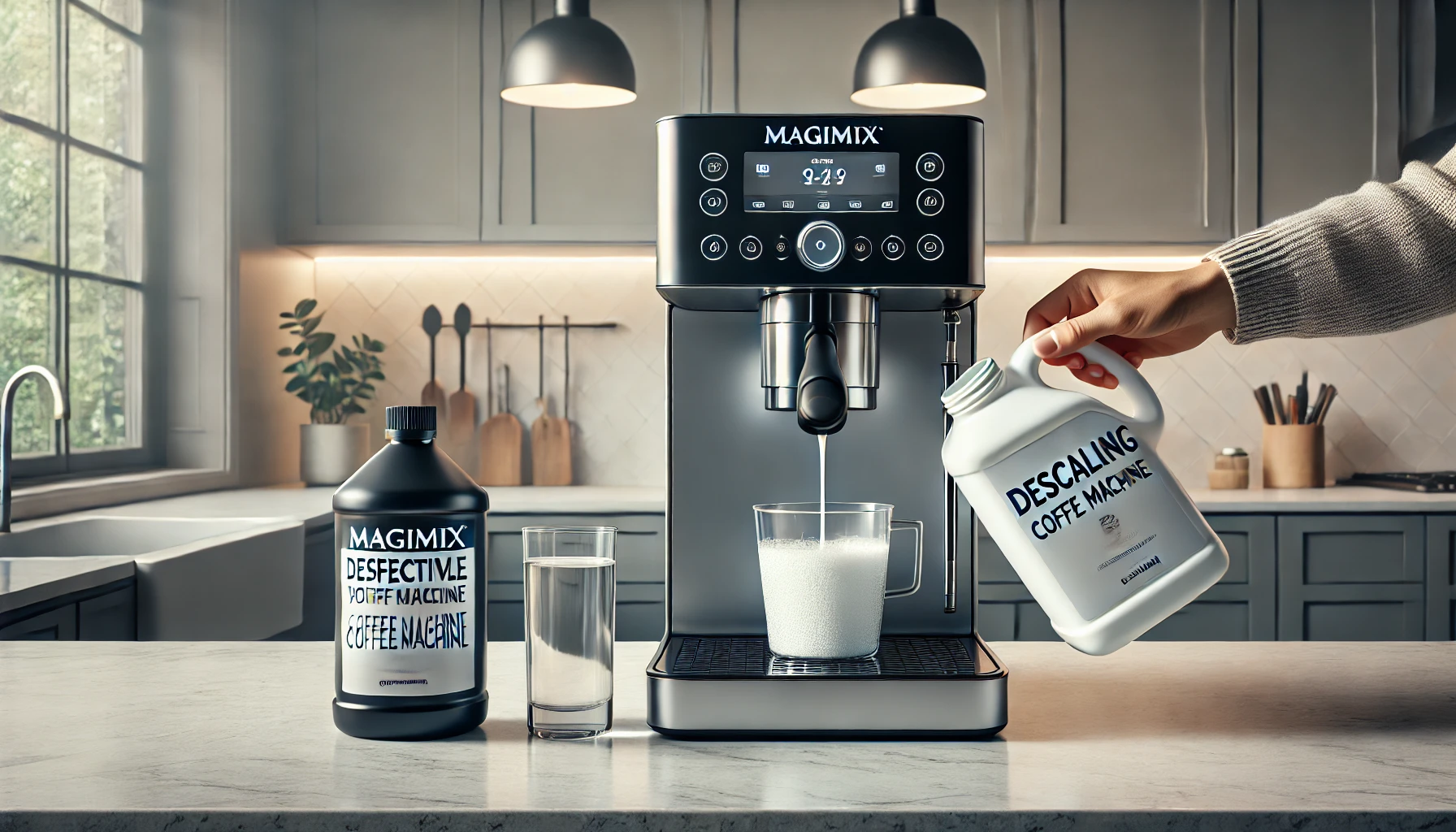There’s nothing quite like the rich aroma of freshly brewed coffee in the morning. But if your Magimix coffee machine hasn’t been descaled in a while, you might notice that your coffee tastes off, takes longer to brew, or isn’t as hot as it should be.
Limescale buildup is the hidden culprit. Hard water deposits can clog your machine, affecting the taste, slowing down performance, and even shortening the lifespan of your beloved coffee maker.
The good news? Regular descaling can fix all of that. In this guide, we’ll walk you through the step-by-step process to effectively descale your Magimix coffee machine, ensuring it runs smoothly and continues to deliver delicious coffee every time.
How Often Should You Descale a Magimix Coffee Machine?
This depends on how often you use it and the hardness of your water. If you’re using your Magimix coffee maker daily, descaling every two to three months is ideal.
However, if you live in an area with hard water, mineral buildup happens faster. In that case, descaling every month may be necessary.
Signs that your machine needs descaling include:
- Your coffee has a bitter or strange taste
- The brewing process takes longer than usual
- The water flow is inconsistent or weak
- The machine makes unusual noises while brewing
If you’re experiencing any of these issues, it’s time to give your coffee machine a thorough clean.
See more: Master Your Coffee Experience: How to Reset Your Nespresso Machine Easily
What You Need to Descale a Magimix Coffee Machine
Before you start, gather the right materials. You can use a commercial descaling solution, like a Magimix-approved descaler, or go the DIY route with white vinegar or citric acid.
Here’s what you’ll need:
- A descaling solution (commercial descaler, white vinegar, or citric acid)
- Fresh water
- A container or cup large enough to hold the descaling liquid from the machine
- A soft cloth or sponge for external cleaning
While vinegar is a popular DIY option, it can leave a strong smell if not rinsed properly. If you prefer a milder alternative, citric acid powder mixed with water works just as well.
Step-by-Step Guide to Descaling a Magimix Coffee Machine
Step 1: Empty and Prepare the Machine
Start by turning off your Magimix espresso machine and unplugging it. Remove any leftover coffee grounds, dispose of used pods (if applicable), and empty the water reservoir.
For best results, clean the drip tray and coffee spout before beginning the descaling process.
Step 2: Mix the Descaling Solution
If you’re using a commercial descaler, follow the instructions on the packaging. Typically, you’ll mix it with a specific amount of water.
For a DIY descaling solution:
- White vinegar method: Mix equal parts vinegar and water
- Citric acid method: Dissolve 1-2 tablespoons of citric acid in a liter of water
Pour the prepared solution into the water reservoir of your Magimix coffee maker.
Step 3: Start the Descaling Cycle
Turn on your Magimix coffee machine and run a brew cycle without coffee. Let the descaling solution flow through the machine, breaking down limescale buildup inside the internal pipes.
Some machines have a descaling mode, while others require you to run a few brewing cycles manually.
Halfway through the process, pause the machine and let it sit for 10-15 minutes. This allows the solution to dissolve stubborn mineral deposits.
After the wait, complete the cycle until the reservoir is empty.
Step 4: Rinse Thoroughly
Once descaling is complete, rinse out any remaining descaling solution by filling the water reservoir with clean water and running several brewing cycles.
It’s crucial to repeat this process 2-3 times to ensure no traces of the descaler remain, especially if you used vinegar. No one wants their morning coffee tasting like vinegar water!
Step 5: Clean the Exterior and Components
Now that the internal descaling process is complete, it’s time to clean the exterior and removable parts of your Magimix coffee machine.
Use a damp cloth to wipe down the machine’s body, ensuring there are no water stains or descaling solution residue.
For the drip tray, coffee spout, and water tank, wash them with warm soapy water and let them air dry before reassembling the machine.
If you use a milk frother, clean it thoroughly, as milk residue can build up and affect performance.
Keeping your Magimix espresso machine clean on the outside not only makes it look new but also helps prevent any lingering odors.
Step 6: Run a Final Rinse and Test Your Coffee
Before you enjoy your next cup, run one last brewing cycle with clean water.
This step ensures that all traces of descaler (especially vinegar or citric acid) are completely flushed out.
Once done, it’s time for the best part—brewing a fresh cup of coffee to test if everything is working properly.
Notice any differences? Your coffee should taste cleaner, smoother, and richer now that the machine is free of limescale buildup.
If you still detect any odd flavors, repeat another rinsing cycle until the taste returns to normal.
Troubleshooting Common Descaling Issues
Sometimes, things don’t go as planned. Here’s how to fix common descaling problems:
1. Machine Still Shows Descaling Alert
Some Magimix models require you to manually reset the descaling indicator after cleaning.
Check your machine’s manual for instructions on how to reset it.
If the alert remains, try running one more descaling cycle, as heavy limescale buildup may need extra cleaning.
2. Coffee Tastes Weird After Descaling
A lingering taste of vinegar or descaling solution can ruin your next brew.
To fix this, run several clean water cycles until the smell and taste completely disappear.
If you used vinegar, add a pinch of baking soda to the rinse cycle to neutralize any remaining acidity.
3. Water Flow Is Still Weak After Descaling
If your Magimix coffee machine is still brewing slowly, there may be mineral deposits blocking the pipes.
Try descaling again, but this time, let the solution sit longer before flushing it out.
Using filtered or soft water in the future can help prevent buildup from returning quickly.
Pro Tips to Prevent Limescale Buildup
- Use filtered water: Hard water causes limescale buildup faster, so switching to filtered or bottled water can reduce the need for frequent descaling.
- Descale regularly: Mark your calendar every 2-3 months (or monthly if you have hard water) to keep your Magimix espresso machine running smoothly.
- Clean removable parts often: Rinse the drip tray, water tank, and milk frother weekly to avoid residue accumulation.
- Store your machine properly: If you don’t use your coffee maker daily, empty the water reservoir before storing it to prevent mold and mineral buildup.
Final Thoughts: Keep Your Magimix Coffee Machine in Top Shape
Descaling may not be the most exciting task, but it’s essential for keeping your Magimix coffee machine in perfect condition.
Regular maintenance not only improves the flavor of your coffee but also prolongs the life of your machine, saving you from costly repairs or replacements.
Now that you know how to descale your Magimix coffee maker, make it a part of your routine.
I’m Jeff Olson, and I love coffee. In fact, I’m something of a professional about coffee. I own and operate coffeemachinenes.com, one of the web’s top resources for everything coffee-related. I’m also an avid home barista, and enjoy experimenting with different brewing methods and flavor profiles. When I’m not nerding out about all things coffee, you can find me playing guitar or spending time with my wife and kids.

